11 Best Laptop Docking Stations in 2025
Eneba Hub contains affiliate links, which means we may earn a small commission if you make a purchase through them—at no extra cost to you. Learn more
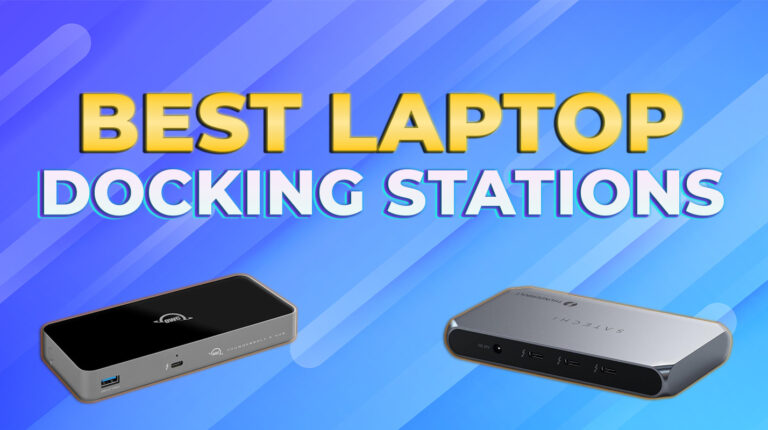
The best laptop docking station can instantly turn your workspace into a clean and efficient setup, especially if your desk’s a mess of cables and dongles. I’ve narrowed down these top picks for 2025, with support for Mac, Windows, and everything in between.
Jump to:
Our Top Picks for Laptop Docking Station
All three of these are backed by trusted reviews, reliable specs, and everyday usability. You’ll get what you pay for, and maybe even more.
- UGREEN Revodok Pro 209 Docking Station (Best Overall) – Solid across the board. This docking station has the basics down: stable USB, strong HDMI output, and dependable power delivery. It works great with both MacBook and Windows setups. Also, it’s currently on sale.
- Anker Prime TB5 14-in-1 Docking Station (Best High-Performance Thunderbolt 5 Dock) – Built for speed and serious multitasking, this Thunderbolt dock provides crazy-fast data rates, dual 4k display support, and enough extra ports for anything you throw at it.
- Sonnet Echo 20 Thunderbolt 4 SuperDock (Best Premium Thunderbolt 4 Dock) – If you’re going all in, this is the one. Premium Thunderbolt 4 performance with amazing monitor support and a sleek design that fits any high-end laptop setup. Ideal for creators and remote pros who need elite gear without compromise.
11 Best Laptop Docking Stations – Upgrade Your Workflow With Smarter Connections
Here are 11 docks that actually improve your setup with better USB access, HDMI connectivity, and everything in between, just real solutions that help you work and create better. Every best laptop docking station here earned its spot, and it may just be the best time to buy one.
1. UGREEN Revodok Pro 209 Docking Station [Best Overall]
Our Score:
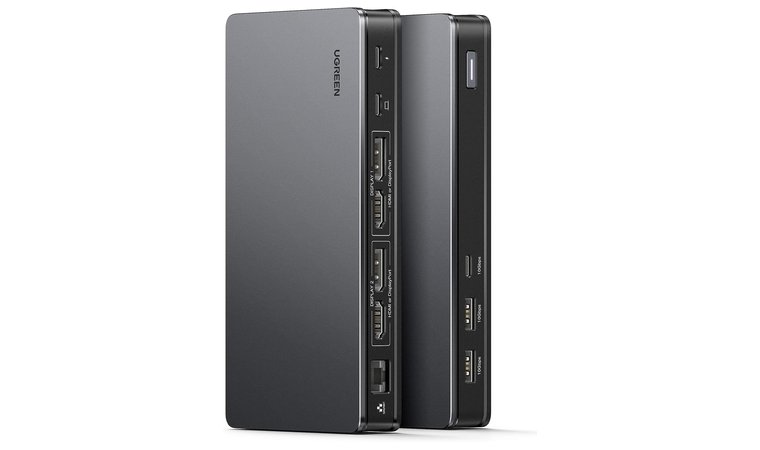
| Specs | Details |
|---|---|
| Type | DisplayLink USB‑C |
| Bandwidth | USB‑C/A 10 Gbps |
| Output Wattage | 100 W USB‑C PD |
| Number of Monitors Supported | 2 |
| Max Resolution per Display | 4K@60 Hz |
| Max Refresh Rate per Display | 60 Hz |
| Port Types | 2×HDMI 2.0, 2×DP 1.2, 1×USB‑C PD, 1×USB‑C data, 2×USB‑A data, 1×Gigabit Ethernet |
| USB Data Ports | 2×USB‑A, 1×USB‑C (all 10 Gbps) |
| Operating Systems | macOS, Windows (DisplayLink driver required) |
The UGREEN Revodok Pro 209 is a pluggable DisplayLink dock that transforms a single USB-C port into a full desktop experience. It supports two monitor outputs at 4K@60 Hz via a mix of HDMI and DisplayPort, which makes it an ideal companion for your high-end gaming laptop.
This dock strikes the balance: compact, powerful, and plug‑and‑play compatible with both Mac and Windows. It’s a reliable all‑rounder that handles dual 4K monitors, offers fast USB data, gigabit ethernet, and up to 85 W power delivery (all for a solid mid-range price).
With one USB-C and two USB-A ports, each offering 10 Gbps speeds, you can use fast SSDs or accessories with minimal fuss. No more dropped calls or lag spikes because its gigabit ethernet locks in a steady connection when your Wi-Fi starts acting up. The 85 W power delivery means you can charge your laptop while working, no extra brick.
It’s compact, the metal shell feels sturdy and helps dissipate heat, and it fits nicely beside your laptop. Installation is instant: plug in and you’re ready to work. Some DisplayLink docks struggle with motion or video playback, but this one handles general productivity and even light video editing surprisingly well.
This one creates a neat, minimal setup. And the price is competitive. Sure, hardcore creators might find USB‑C video pass-through slower than native Thunderbolt, but for most users, this dock brings huge value.
| Pros | Cons |
|---|---|
| ✅ Connects dual 4K monitors via HDMI & DP – boost your desktop real estate ✅ 85 W charging power to laptop – cuts down on adapters ✅ Fast 10 Gbps USB-C and USB-A ports for storage ✅ Gigabit Ethernet built-in – stable connection for work or streaming ✅ Compact aluminium form – stable, thermally smart build ✅ Clean layout with smart port spacing ✅ Works across macOS and Windows systems | ❌ Not built for heavy gaming rigs or GPU passthrough, but it handles everyday tasks smoothly and reliably |
Turn on the power switch after plugging in. It cuts power to unused ports and reduces heat.
Final Verdict: If you want the best-selling docking station that just works for dual displays, USB speed, charging, and network without breaking the bank, this is it. Great for hybrid users who need reliability and full connectivity without paying for overkill.
2. Anker Prime TB5 14-in-1 Docking Station [Best High-Performance Thunderbolt 5 Dock]
Our Score:
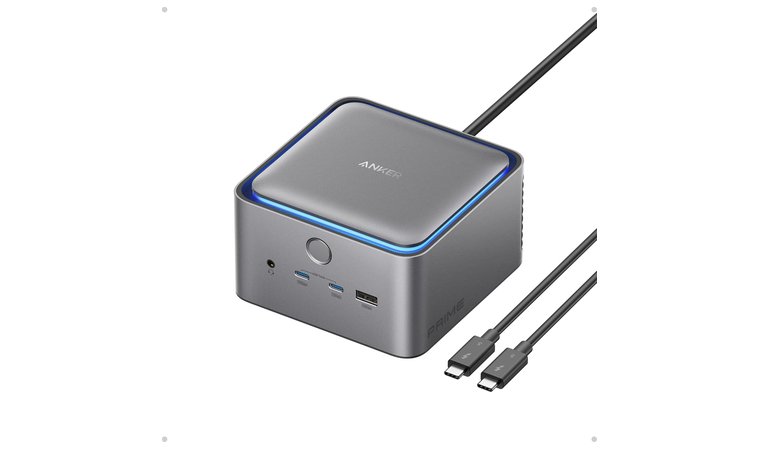
| Specs | Details |
|---|---|
| Type | Thunderbolt 5 |
| Bandwidth | Up to 120 Gbps |
| Output Wattage | 140 W upstream, 45 W to peripherals |
| Number of Monitors Supported | 2 |
| Max Resolution per Display | Up to 8K (Windows), 6K (Mac) |
| Max Refresh Rate per Display | Up to 60 Hz depending on resolution |
| Port Types | 1×TB5 upstream, 2×TB5 downstream, 1×HDMI 2.1, 1×DP 2.1, 2×USB‑C, 3×USB‑A, SD/TF reader, 2.5 GbE, 3.5 mm audio |
| USB Data Ports | 3×USB‑A 10 Gbps, 2×USB‑C 10 Gbps |
| Operating Systems | Windows, macOS 15+ (TB5 host required) |
Anker’s Prime TB5 is a space-efficient square dock that packs a serious punch. It allows up to 140 W charging to your laptop from the built-in GaN power supply, plus 232 W total output to run everything else.
This is Anker’s first Thunderbolt 5 dock with built‑in GaN power and ultra-fast data lanes. It powers up a dual 4K or 8K setup while charging your laptop at 140 W, plus supports huge file transfers via TB5 lanes. Future‑proof and premium, but still under mainstream price compared to pro docks.
Dual Mongo connections mean you can hook up either dual 8K displays or high-refreshed 4K panels. Two TB5 downstream ports offer up to 120 Gbps data speed, perfect for fast SSDs or heavy file transfers.
You get two fast front USB-C ports (shared 45 W for charging/transfer), three USB-A ports, SD/TF card slots, Gigabit Ethernet, audio jack, and ambient LED lighting. You won’t be stuck with outdated features; firmware updates roll in remotely, so it keeps getting better over time.
It’s compact, sleek, and built with a Mac-style aluminum finish that looks great next to a MacBook, but works equally well with Windows laptops.
This dock is ideal if you want maximum connection and bandwidth in a stylish, compact package. It’s pricier than simpler stations, but worth it if you need future-ready Thunderbolt performance.
| Pros | Cons |
|---|---|
| ✅ Supports 8K or dual 4K @ 60 Hz – for future-proof display use ✅ 140 W laptop charging via Thunderbolt upstream – fast power delivery ✅ Massive bandwidth 120 Gbps downstream – great for SSDs & data transfers ✅ Built-in GaN PSU eliminates bulky bricks ✅ Multiple USB‑C/A, HDMI or DP options, SD/TF slots, Ethernet ✅ Compact, stylish aluminum housing – clean desktop ✅ Firmware updates via Dock Manager – keeps compatibility fresh | ❌ A bit pricier than USB-C docks, but you get premium Thunderbolt 5 performance in return |
| PRO TIP |
|---|
| Hook up one screen through HDMI 2.1 and the other through DisplayPort 2.1 to get the smoothest refresh rates, especially if you’re on Windows and aiming for that 8K setup. |
Hook up one screen through HDMI 2.1 and the other through DisplayPort 2.1 to get the smoothest refresh rates, especially if you’re on Windows and aiming for that 8K setup.
Final Verdict: For high-power users wanting Thunderbolt speeds, heavy file transfers, and display flexibility, this is the go‑to choice. Stylish and powerful, it’s a top-tier dock that’ll serve well for years.
3. Sonnet Echo 20 Thunderbolt 4 SuperDock [Best Premium Thunderbolt 4 Dock]
Our Score:
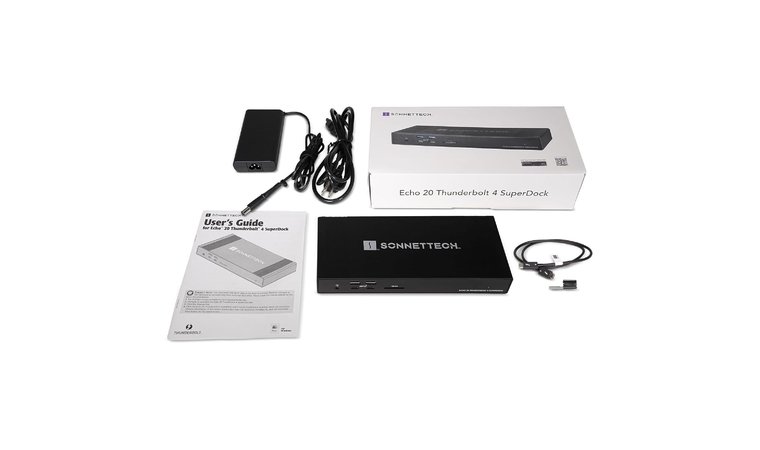
| Specs | Details |
|---|---|
| Type | Thunderbolt 4 |
| Bandwidth | 40 Gbps |
| Output Wattage | Up to 100 W PD |
| Number of Monitors Supported | Dual or single 8K |
| Max Resolution per Display | 8K@60 Hz HDMI, up to dual 6K via TB4 |
| Max Refresh Rate per Display | Up to 240 Hz for lower resolutions |
| Port Types | 3×TB4 (one host), HDMI 2.1, 2.5 GbE, 4×USB‑C 3.2 Gen 2, 4×USB‑A 3.2 Gen 2, SD, M.2 slot, combo audio jacks |
| USB Data Ports | 8× 10 Gbps ports (both USB‑A and USB‑C) |
| Operating Systems | macOS, Windows (Intel/Apple Silicon) |
The Sonnet Echo 20 SuperDock is a TB4 beast. It delivers 100 W charging via your Thunderbolt connection, and provides three TB4 ports, one to your host and two for other devices/monitors. Those ports deliver legit 40 Gbps speeds, no bottlenecks in sight.
If you want serious docking station muscle, with built‑in NVMe expansion, HDMI 8K 60 Hz, plenty of USB, ethernet, and power, this is the one. It’s packed, rugged, and handles heavy-duty workflows for creators and pros.
It includes HDMI 2.1 support for a single 8K display at 60 Hz, or dual 6K/4K outputs with adapters. It also has four fast USB‑A ports and four USB‑C charging/data ports (7.5 W each), plus a 2.5 Gb Ethernet port, headphone/mic jacks, RCA out, SD card slot, and an M.2 SSD slot built into the dock itself.
You’re also getting a sturdy all-metal build that feels premium. Also, it’s the only dock in this lineup with a built-in SSD slot for extra storage, compatible with both macOS and Windows out of the box.
This is the go-to dock for pros who need extra storage built right in, without sacrificing display quality or network reliability. From editing massive files or syncing across heavy workflows, it keeps up without flinching, which gives you the bandwidth you need to play the best PC games.
| Pros | Cons |
|---|---|
| ✅ Built-in M.2 SSD slot – expandable internal storage ✅ HDMI 2.1 supports 8K @ 60 Hz display – future-ready visuals ✅ Three TB4 ports (host + 2 downstream) – strong multi-device support ✅ 2.5 Gb Ethernet for serious networking speed ✅ Plenty of USB-A and USB-C data/charging ports ✅ High compatibility with macOS and Windows TB4/USB4 systems ✅ Solid metal build – feels premium and durable | ❌ Might be more than necessary for basic port needs, but great if you want top-tier features |
Install an NVMe SSD from the dock’s bottom access point; it removes cable clutter and turns the dock into a mini storage hub.
Final Verdict: This is the best premium choice if you want serious power, storage, future-ready connection, and display support in one sleek station. A worthy upgrade for creators and multitaskers.
4. iVANKY 20-in-1 FusionDock Pro 2 [Best DisplayLink Dock for Power Users]
Our Score:
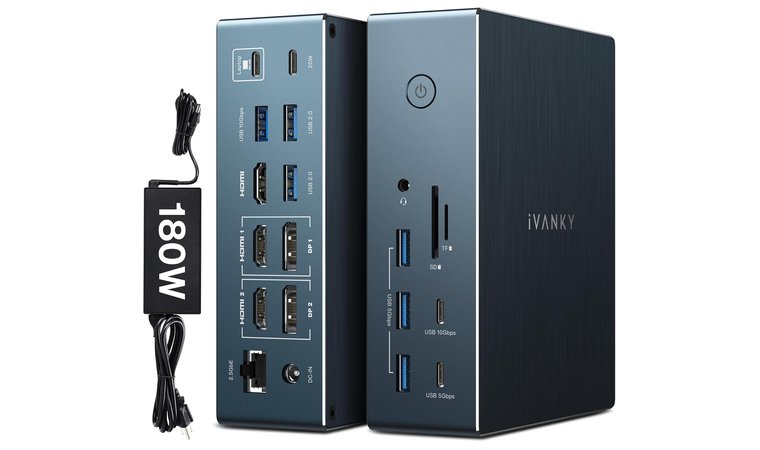
| Specs | Details |
|---|---|
| Type | DisplayLink USB‑C |
| Bandwidth | USB‑C/A 10 Gbps |
| Output Wattage | 100 W PD |
| Number of Monitors Supported | 3 |
| Max Resolution per Display | Triple 4K@60 Hz |
| Max Refresh Rate per Display | 60 Hz |
| Port Types | 3×HDMI 2.0, 2×DP 1.2, 2×USB‑C (PD and data), 4×USB‑A, SD/TF readers, Gigabit Ethernet |
| USB Data Ports | 4×USB‑A, 2×USB‑C (all 10 Gbps) |
| Operating Systems | macOS, Windows (DisplayLink driver required) |
The iVANKY FusionDock Pro 2 was made for serious multitaskers. With support for three 4K displays at 60 Hz via HDMI and DisplayPort, it transforms a single laptop USB‑C port into a full workstation.
Designed for power users who need triple 4K displays from a single USB‑C port, the iVANKY FusionDock Pro 2 brings fast 2.5 Gbps Ethernet and reliable DisplayLink compression. It’s perfect for multitasking professionals who require display expansion beyond native GPU limits.
DisplayLink tech enables unexpected display setups even on machines with limited native output, ideal if you need more monitors fast. You get plenty of USB connectivity: two USB‑C ports capable of 10 Gbps and PD, plus three USB-A Gen 2 ports and two Gen 1 for accessories. Media transfer gets a boost from SD/TF card readers, while 2.5 GbE keeps your network rock‑steady. Despite the many ports, it stays relatively compact and keeps wires tidy.
Even with DisplayLink compression, general productivity, spreadsheets, coding, and light video streaming stay smooth. For gaming or motion-heavy video, minor latency might show, but for most work, it’s rock‑solid. The price is fair given the port count and display power. Setup requires installing drivers, but after that, it’s plug-and-play for multiple monitor output.
This dock is best if you need extra connection options beyond what DisplayLink supports. It’s a good buy for creators and workers juggling many windows and devices.
| Pros | Cons |
|---|---|
| ✅ Supports triple 4K @ 60 Hz displays to expand your view ✅ Fast USB‑C/A ports for peripheral and data power ✅ 2.5 GbE port for high-speed wired connection ✅ SD/TF 4.0 readers for fast media imports ✅ Up to 100 W laptop charging via PD upstream ✅ Solid aluminum build, compact footprint | ❌ DisplayLink latency can affect intense motion tasks, yet it’s perfect for most everyday work |
Install the correct DisplayLink manager driver before plugging in HDMI ports 2 and 3. Without it, those displays might not activate.
Final Verdict: If your setup always feels cramped or cluttered, this dock clears the chaos with smooth screen expansion and reliable USB-C performance. A clear winner for power users who need more monitor flexibility without native GPU support.
5. UGREEN Thunderbolt 4 Dock Revodok Max 213 13-in-1 [Best for Mac & Surface]
Our Score:
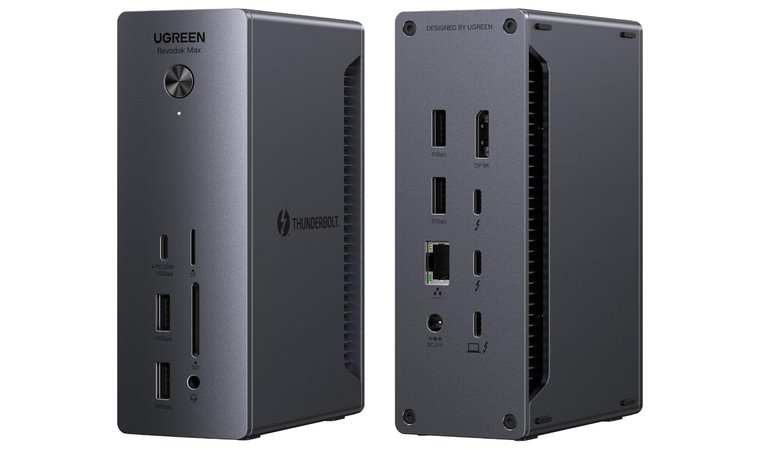
| Specs | Details |
|---|---|
| Type | Thunderbolt 4 |
| Bandwidth | 40 Gbps |
| Output Wattage | Up to 90 W PD (plus 20 W USB‑C) |
| Number of Monitors Supported | 2 |
| Max Resolution per Display | Dual 4K@60 Hz or single 8K@30 Hz |
| Max Refresh Rate per Display | 60 Hz |
| Port Types | 2×TB4 downstream, 1×TB4 upstream, 1×DP 1.4, 2×USB‑C, 4×USB‑A, SD/TF card slot, 2.5 GbE, 3.5 mm audio |
| USB Data Ports | 2×USB‑A Gen 2, 1×USB‑C Gen 2 |
| Operating Systems | Surface, macOS, Windows (supports TB4/TB3/USB4/USB‑C) |
The UGREEN Revodok Max 213 is built like a tank. With two Thunderbolt 4 downstream ports and a DisplayPort 1.4, you get rock-solid dual 4K at 60 Hz or even 8K at 30 Hz. It’s ready to handle serious screen setups without flinching, which makes it ideal for the best gaming monitor setups.
This dock is a powerful Thunderbolt 4 station ideal for [Mac] and Surface users. It combines Thunderbolt speed, abundant ports, 90 W charging, and support for either dual 4K or single 8K displays, all within a sturdy aluminum chassis at a competitive price.
It charges your laptop with up to 90 W while the included 180 W GaN charger powers other connected devices. Data moves at full Thunderbolt 4 speed, perfect for pushing NVMe drives to their limit or flying through massive transfers without lag.
Its port suite is plentiful: USB‑C and USB‑A at 10 Gbps, SD/TF card slots (UHS‑II), 2.5 GbE Ethernet, audio in/out, and even an HDMI 2.1 output. The dock supports macOS and Windows machines equally, and works with TB3 and USB4 systems. Despite the big metal build, it can be placed vertically to save desk space.
When your setup demands clean performance (meaning no screen lag, no slow drives, and no flaky connections), this dock keeps it tight and professional without the clutter. Testing from PCWorld and TechRadar praised its thermal design and port selection, even calling it UGREEN’s answer to CalDigit TS4.
| Pros | Cons |
|---|---|
| ✅ Full TB4 bandwidth (40 Gbps) for fast data transfer ✅ 90 W host charging maintains power and flow ✅ Dual 4K60Hz or single 8K support via TB4/DP ✅ Plenty of USB‑C/A and SD/TF slots ✅ 2.5 Gb Ethernet for stable connection ✅ Rugged aluminum build – durable and cool ✅ Excellent compatibility with Mac, Windows, and Surface laptops | ❌ Takes up more desk space due to its size, but packs plenty of ports for Mac and Surface users |
Orient the dock vertically on your desk to reduce its footprint and improve airflow without sacrificing port access.
Final Verdict: Built with Mac and Surface power users in mind, this dock brings serious output muscle, display flexibility, fast charging, and a future-ready design that won’t buckle under tomorrow’s workloads.
6. Satechi Thunderbolt 4 Dock Slim Hub Pro [Best Slim Thunderbolt 4 Laptop Docking Station]
Our Score:
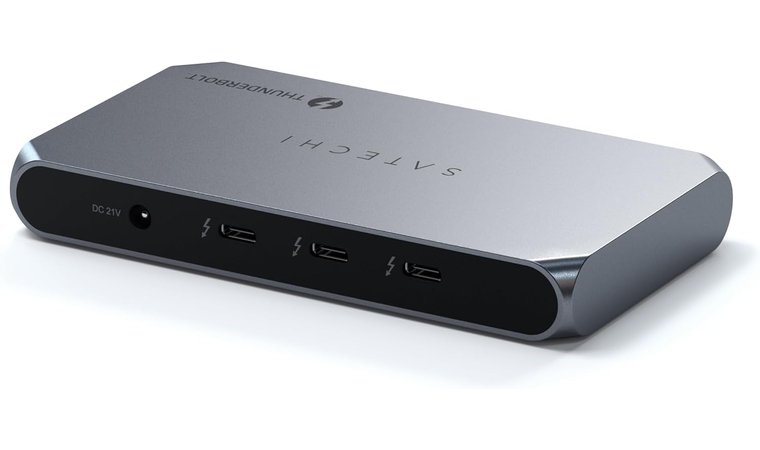
| Specs | Details |
|---|---|
| Type | Thunderbolt 4 |
| Bandwidth | 40 Gbps |
| Output Wattage | 96 W PD |
| Number of Monitors Supported | 2 |
| Max Resolution per Display | Dual 4K@60 Hz or single 8K@30 Hz |
| Max Refresh Rate per Display | 60 Hz |
| Port Types | 3×TB4 downstream, 1×TB4 upstream, 1×USB‑A 10 Gbps |
| USB Data Ports | 1×USB‑A 10 Gbps |
| Operating Systems | macOS, Windows (Thunderbolt 4 host required) |
The Satechi Slim Hub Pro brings new sophistication to compact docking. With its small footprint, it packs three TB4 downstream ports and one TB4 upstream to connect your laptop, all running at 40 Gbps each.
This new slim dock delivers full Thunderbolt 4 bandwidth in a super sleek package. It charges your laptop at 96 W while driving dual 4K or 8K visuals and daisy‑chains up to six plugable TB4 devices, ideal for users who want power without bulk.
Visual output supports dual 4K@60 Hz or single 8K@30 Hz on Windows systems; macOS restricts 8K support beyond M-series pros. The 150 W GaN brick pumps 96 W straight to your laptop while keeping 15 W on standby for your gear. That’s serious wattage in a slim form.
The only USB‑A port is gen‑2 (10 Gbps), but you still get fast connectivity for drives or accessories. Daisy chain up to six Thunderbolt devices, including SSDs, displays, audio interfaces, and even an eGPU, all through a single cable. It’s that clean.
Its metal body fits easily in a backpack and looks clean beside a MacBook or Windows setup. Responsiveness stays tight even when you’re multitasking, writing code, editing, or tweaking assets; fluid workflow all around.
For heavy video or GPU output, this dock still holds strong, though it lacks an Ethernet port. It’s super perfect for minimalist setups that demand high power and modern port expansion.
| Pros | Cons |
|---|---|
| ✅ Compact TB4 hub that takes almost no desk space ✅ Up to 96 W charging, great for high‑power laptops ✅ Dual 4K or single 8K output; sharp visuals ✅ Daisy‑chain up to 6 TB4 devices ✅ Sleek aluminum design for premium look ✅ Full 40 Gbps per port, top-end bandwidth | ❌ Only one USB‑A data port, though most users can still connect their essentials just fine |
M1 and M2 MacBook users can unlock dual-display setups via Clamshell mode, and yep, it still fits Satechi’s ultra-slim, desk-friendly design without breaking a sweat.
Final Verdict: If you want Thunderbolt 4 speed in a minimalist station, with dual 4K/8K support, 96 W charging, and daisy‑chain flexibility, this is the new go‑to dock for sleek, portable power users.
7. Baseus 11 in 1 Laptop Docking Station [Best Universal USB-C Dock for Triple Monitors]
Our Score:
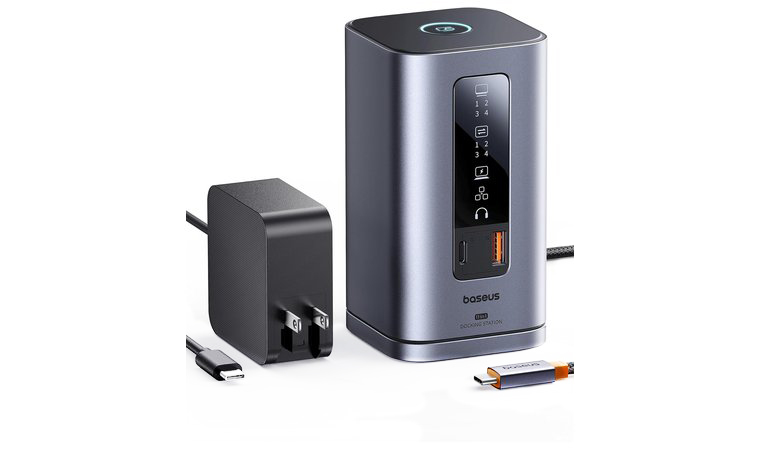
| Specs | Details |
|---|---|
| Type | USB‑C DisplayLink |
| Bandwidth | USB‑C/A 10 Gbps |
| Output Wattage | 100 W PD |
| Number of Monitors Supported | 3 |
| Max Resolution per Display | Triple 4K@30 Hz |
| Max Refresh Rate per Display | 30 Hz |
| Port Types | 3×HDMI, 1×USB‑C PD, 1×USB‑C data, 3×USB‑A, Gigabit Ethernet, SD/TF |
| USB Data Ports | 3×USB‑A, 1×USB‑C (10 Gbps) |
| Operating Systems | macOS, Windows (DisplayLink driver needed) |
The Baseus Spacemate 11‑in‑1 station is a versatile USB‑C dock that adds massive monitor support and port expansion at a competitive price. You can plug into two HDMI and two DisplayPort outputs, or swap one for VGA, and run up to three 4K displays at 60 Hz on Windows.
This dock is ideal if you need triple monitor support without Thunderbolt. With 11 ports, support for three 4K screens, and fast USB data, all under a modest price and no bulky PSU in the package, this is a go‑anywhere universal choice.
Your laptop gets up to 85 W of charge, while USB‑C and USB-A ports move files at blazing 10 Gbps speeds. With gigabit ethernet for stable performance, plus audio and card slots built-in, this dock keeps your desk setup clean and capable.
The dock is compact, with a magnetic base that sticks to your desk. Freshly designed with a plug-and-play vibe, this dock works smoothly across both Windows and newer macOS laptops (just make sure yours supports DP Alt Mode).
Triple display capability is rare at this tier. It’s not as fast as Thunderbolt 4, but for general multitasking, coding, designing, or content review, it’s solid value.
| Pros | Cons |
|---|---|
| ✅ Drives up to three 4K @ 60 Hz displays ✅ 100W charging supports ✅ USB‑A and USB‑C ports at 10 Gbps for peripherals and storage ✅ Ethernet and audio ports built-in ✅ Magnetic base keeps dock stable on desk ✅ Easy compatibility with most USB‑C laptops | ❌ Not built for high-speed gaming or editing, but handles daily multitasking and triple-display setups like a champ |
Use the built-in SD/TF card readers for quick media transfer; no extra dongles needed.
Final Verdict: If you’re all about getting things done without overspending, this hub packs real utility into a budget-friendly form. It’s built for flexible multitasking, even with non-Thunderbolt machines; it’s a smart choice for everyday pros.
8. Dell Universal Dock UD22 Black [Best for Dell Laptops]
Our Score:
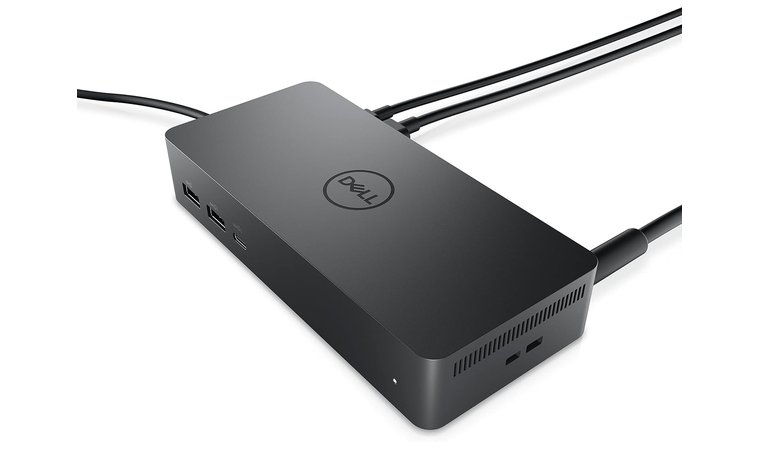
| Specs | Details |
|---|---|
| Type | USB‑C with DisplayLink |
| Bandwidth | USB‑C/A 10 Gbps |
| Output Wattage | 130 W PD for Dell, 90 W for others |
| Number of Monitors Supported | 3 |
| Max Resolution per Display | Triple 1080p or dual 4K@60 Hz |
| Max Refresh Rate per Display | 60 Hz |
| Port Types | 2×HDMI, 1×DisplayPort, USB‑C PD, 4×USB‑A, 1×USB‑C data, Gigabit Ethernet, audio |
| USB Data Ports | 4×USB‑A, 1×USB‑C (10 Gbps) |
| Operating Systems | Windows, macOS (DisplayLink driver) |
The Dell Universal Dock UD22 is engineered for Dell users who want reliability. Plug in your Dell laptop via USB‑C, and the dock handles video output via HDMI or DisplayPort, offers Gigabit Ethernet, plenty of USB‑A/C ports, and delivers ~90 W charging.
As Dell’s own universal dock, this unit’s made to snap right into your setup, especially if you’re on a Dell laptop. This one guarantees smooth performance that fits right into the ecosystem.
Since it’s officially Dell-certified, everything runs tighter. It also feels like your system talks to the dock like it’s built-in. Don’t get me started on the setup; it’s instant; you just need to plug it in, and you’re ready to go without dealing with installs or tweaks.
The dock holds steady no matter what your workflow looks like. You get sharp visuals up to 4K and a seamless connection to your gear.
Dell’s brand support gives you peace of mind, updates, and compatibility checks on Dell.com. It’s not new, but it’s dependable. If you’re rocking a Dell laptop and want a dock that just works, this station removes the guesswork.
| Pros | Cons |
|---|---|
| ✅ Certified by Dell for seamless compatibility ✅ Stable charging (~90 W) and Ethernet ✅ Triple monitor capability ✅ Reliable firmware updates and official support ✅ USB‑C and USB‑A ports for peripherals ✅ No tricky driver installs ✅ Streamlined setup for Dell users | ❌ Fewer third‑party reviews outside the Dell ecosystem, yet it’s been solid for Dell users looking for plug-and-play simplicity |
Keep your Dell BIOS and drivers updated to unlock the UD22’s full feature set and maintain charging/display stability.
Final Verdict: If you use a [Dell laptop], this is the safest, most consistent dock out there. Official support, stable power, and plug‑and‑play design make it a solid choice for work and productivity.
9. OWC Thunderbolt 5 Hub [Best Docking Station for Port Expansion and Daisy Chaining]
Our Score:
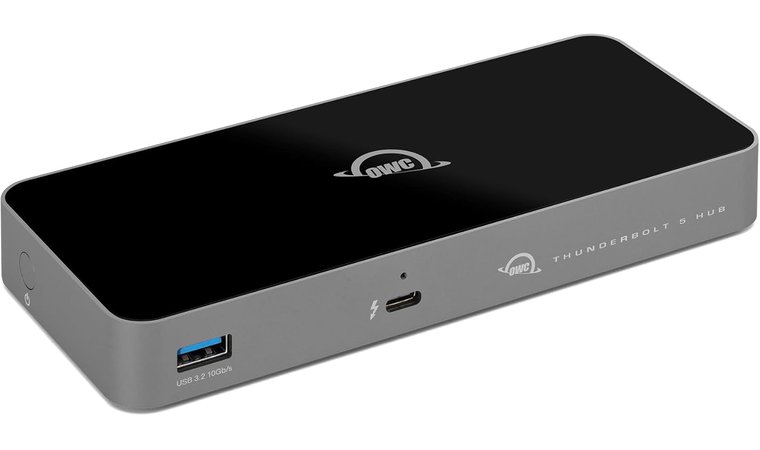
| Specs | Details |
|---|---|
| Type | Thunderbolt 5 Hub |
| Bandwidth | Up to 120 Gbps shared |
| Output Wattage | 60 W PD upstream (host must supply full power) |
| Number of Monitors Supported | 1 display directly, more via the dock chain |
| Max Resolution per Display | 8K@60 Hz or dual 4K monitors via chaining |
| Max Refresh Rate per Display | 60 Hz |
| Port Types | 1×TB5 upstream, 2×TB5 downstream, 1×USB‑C, 1×USB‑A |
| USB Data Ports | 1×USB‑C, 1×USB‑A (10 Gbps) |
| Operating Systems | macOS, Windows with TB5 host |
OWC’s Thunderbolt 5 Hub pushes docking tech into its next era. This hub takes one TB5 port and turns it into a full-blown expansion rig. Depending on your laptop, you can run up to three high-res displays, even dual 8Ks at smooth refresh rates, while still plugging in GPUs, fast storage, and pro-level audio gear from that same connection.
The OWC TB5 Hub is built for users needing extreme daisy‑chain setups. With TB5’s full 120 Gbps lanes and support for up to three high-res monitors, it’s unmatched for future-proof port expansion and chaining devices.
With up to 120 Gbps per lane, the speed ceiling is insanely high and perfect for workflows where you can’t afford bottlenecks. From editing raw footage and managing layered sessions to powering heavy-duty gear without extra power bricks, this hub keeps up. And as more devices catch up to TB5, it’s ready to scale with you.
This hub is brand-new and not yet mainstream, which means ecosystem compatibility may still grow. If you’re building a plugable, future‑proof chain, OWC’s TB5 setup is unmatched.
| Pros | Cons |
|---|---|
| ✅ Thunderbolt 5 bandwidth: up to 120 Gbps per lane ✅ Supports up to three high‑res monitors, a rare capability ✅ Excellent daisy‑chain for TB5-ready SSDs, eGPUs, etc. ✅ Compact, future-forward design ✅ Expands one TB5 port into full workstation setup ✅ Strong build from a trusted pro brand | ❌ Host device support is still catching up, but future-ready if you’re building around Thunderbolt 5 |
Use high-quality TB5-certified cables and peripherals to fully take advantage of the 120 Gbps speeds and present full resolution on chained displays.
Final Verdict: If new Thunderbolt 5 adoption is important to you, and you plan to add devices over time, this hub is your future-ready expansion anchor. Great for creators and pros building heavy daisy‑chain setups.
10. Kensington UH1510P USB C Hub 11-in-1 [Best USB-C Dock for Business Laptops]
Our Score:
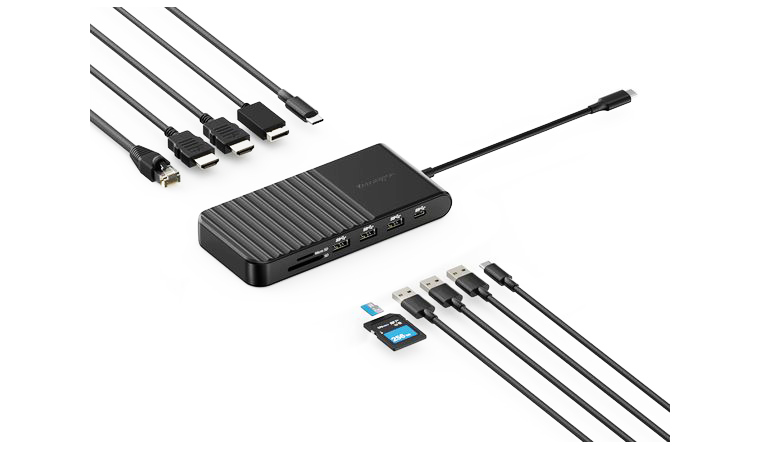
| Specs | Details |
|---|---|
| Type | USB‑C with DisplayLink |
| Bandwidth | USB‑C/A 10 Gbps |
| Output Wattage | 100 W PD |
| Number of Monitors Supported | 2 |
| Max Resolution per Display | Dual 4K@30 Hz |
| Max Refresh Rate per Display | 30 Hz |
| Port Types | 3×HDMI, 1×USB‑C PD, 1×USB‑C data, 4×USB‑A, Gigabit Ethernet, SD/TF, audio |
| USB Data Ports | 4×USB‑A, 1×USB‑C (10 Gbps) |
| Operating Systems | macOS, Windows (DisplayLink driver) |
This dock is no-frills and all function. It’s physically secure (yes, lock slot’s there) and works effortlessly with major work laptops from Dell, HP, or Lenovo. My favorite part is how instant the setup is; just plug in via USB-C, and it’s ready. External displays look sharp at 4K, and your connection won’t flinch thanks to a steady Gigabit port.
Kensington builds with business in mind. The UH1510P packs everything a pro setup needs into a clean aluminum shell, ready to handle daily use on the go or at the desk. It’s built to meet enterprise demands without overcomplicating things.
Accessories connect easily via USB-A/C ports, including your best mechanical keyboard. Sure, it may lack extreme gaming-specific features or TB4 speeds, but it chooses reliability over bells and whistles.
This dock is best suited for standardized office gear where stability beats bleeding-edge tech. If your priority is reliability across a wide rollout, this thing fits right in.
| Pros | Cons |
|---|---|
| ✅ Business-certified build and durability ✅ Pass-through charging for laptops (~85 W) ✅ Quick plug-and-play setup, no driver fuss ✅ Ethernet, HDMI/DP, USB ports for office essentials ✅ Compact, lockable docking station design ✅ Enterprise support and firmware stability | ❌ Doesn’t support Thunderbolt, but USB‑C bandwidth is still solid for most business tasks |
Use the Kensington lock slot to secure the dock in shared office environments for added safety (and peace of mind).
Final Verdict: If you’re kitting out a corporate laptop, this dock has the essentials locked down: stable connections, power passthrough, and enough ports to keep productivity flowing. It’s not flashy, but it works.
11. Plugable Thunderbolt 4 Dock [Best Driverless USB-C Dual Monitor Dock]
Our Score:
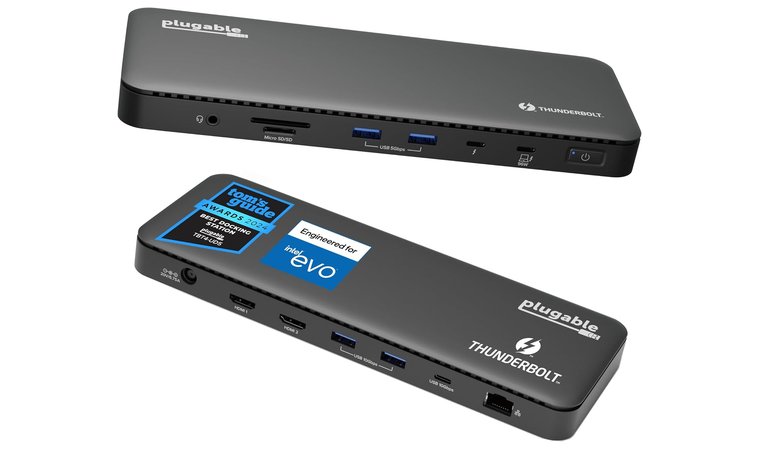
| Specs | Details |
|---|---|
| Type | Thunderbolt 4 |
| Bandwidth | 40 Gbps |
| Output Wattage | 96 W PD |
| Number of Monitors Supported | 2 |
| Max Resolution per Display | Dual 4K@60 Hz |
| Max Refresh Rate per Display | 60 Hz |
| Port Types | 3×TB4 downstream, 1×TB4 upstream, 1×USB‑A 10 Gbps, Gigabit Ethernet, audio |
| USB Data Ports | 1×USB‑A (10 Gbps) |
| Operating Systems | macOS, Windows (no driver needed) |
Plugable’s Thunderbolt 4 Dock merges real TB4 bandwidth and DisplayLink video tech in one station. You can connect two HDMI displays (DisplayLink) and still use two more via Thunderbolt ports at 4K@60 Hz each, or go single 8K.
This new Plugable TB4 dock is rare; it offers driverless Thunderbolt ports and DisplayLink HDMI outputs, so you can plug up to dual HDMI monitors without a separate adapter. Perfect for users who want easy dual/Dual‑4K support with no complicated setups.
The host charging up to 96 W keeps your laptop powered, and the dock includes Ethernet, SD, USB‑A, and USB‑C expansion as well. What makes it stand out? True plug-and-play video via Thunderbolt ports (no drivers needed) and DisplayLink HDMI support for extra screens. That means you can get dual display outputs working without fuss, even on macOS or Windows.
The DisplayLink driver is needed only for HDMI, but TB4 ports work driverless. Great for hybrid offices or users who want an easy, expandable display without losing performance or complexity. Ideal for remote or multi-monitor setups, it supports both heavy-duty TB4 devices and easy HDMI hookup without spending hours configuring.
| Pros | Cons |
|---|---|
| ✅ Supports up to 4 monitors (2× HDMI + 2× TB4) ✅ Full 96 W charging supports most laptops ✅ True TB4 bandwidth on C ports, no throttling ✅ Ethernet, SD, USB-A/C ports for full expansion ✅ Mix of driverless and driver-supported display options ✅ Great compatibility with MacBook Pro/Max and Windows ✅ Seamless plug and play for TB ports | ❌ DisplayLink output may introduce minor latency in video-heavy use, but it’s smooth for general multitasking |
Leave HDMI ports unplugged until after the DisplayLink driver is installed; pre-install avoids driver conflicts on macOS or Windows.
Final Verdict: If you want a plugable, dual-monitor TB4 dock that’s easy to set up and still powerful, this is it. It combines fast port speeds, up to dual 4K output, and hassle-free driver use, which makes your setup a breeze for remote and home office setups.
How to Pick a Laptop Docking Station
Choosing the best laptop docking station depends on how you work and what you’re plugging in. If you’re building a permanent setup or hunting for a compact travel beast, it all comes down to finding the right mix of compatibility, connectivity, charging support, and physical design. Let’s break this down.
Compatibility
Not all docks play nice with all laptops, and this is where most people get tripped up. So here’s a crash course on the types you’ll see:
- Thunderbolt (3, 4, and 5) – These ports look like USB-C but offer far higher bandwidth and performance. Thunderbolt 4 is the most common right now; it gives you fast data transfer and dual 4K/8K display support. Thunderbolt 5 is starting to roll out, but only compatible with newer laptops.
- USB-C (USB 3.1/3.2, USB4) – Most modern docks rely on USB-C. Just watch out: not all USB-C ports are equal. Some only support data, others support video and charging. USB4 is the most versatile, with speeds close to Thunderbolt and full backward compatibility.
- DisplayLink Technology – Great for multi-monitor setups, especially if your laptop doesn’t natively support multiple external displays. It taps into software drivers to push extra displays, though you might see a small dip in GPU performance depending on your workload.
- Laptop Brand/Model Specificity – Some docks are tailor-made for specific brands (like Dell UD22 for Dell laptops). Always check compatibility lists and reviews before buying.
Connectivity
Start by listing what you actually plug into your laptop, then add 2–3 extras for future-proofing.
- Display Outputs (HDMI, DisplayPort, USB-C/Thunderbolt) – These are essential for dual/triple-monitor setups. HDMI and DisplayPort are standard, but some docks use USB-C/Thunderbolt to support high-res displays. Check your monitor input too.
- USB Data Ports (USB-A, USB-C) – You’ll need these for keyboards, mice, hard drives, and USB mics. USB 3.1/3.2 means faster transfer speeds, especially for top external SSDs. The more, the better.
- Ethernet (Gigabit, 2.5GbE) – Wired internet = lower latency. If you work remotely, a Gigabit or even 2.5GbE port is a huge plus.
- SD/MicroSD Card Readers – Creators and photographers, this one’s for you. A full-size SD card slot can save you from carrying around extra dongles.
- Audio Jacks (3.5mm) – Some docks include a combo mic/headphone jack. Not a must-have for everyone, but handy for quick plug-and-play audio.
- Power Button/Other Convenience Features – Some desktop docks come with built-in power buttons, LED indicators, or even physical on/off toggles. Small details, big impact.
Power Delivery
Power Delivery (PD) is what lets your dock charge your laptop through a single cable. It’s perfect for clean setups, but only if it matches your laptop’s needs.
Here’s how it works:
PD ratings vary: 60W, 85W, 100W, and even 140W. If your laptop draws 100W and your dock only supplies 60W, it’ll charge slowly or not at all while under load. On the flip side, over-delivering isn’t dangerous; your device will just draw what it needs.
Pro tip: MacBook Pro 16” users should aim for 96W+ docks. Ultrabooks like Dell XPS or Surface laptops usually get by with 60W–85W. What I’m trying to say is: match the PD rating to your laptop’s original charger output, and always check if the dock includes a power brick.
Form Factor & Design
Docks come in all shapes and sizes, and the right one depends on your lifestyle:
- Desktop Docks – Big, loaded with ports, and made to live on your desk. Ideal for hybrid workers or gamers. Some have weighted bases or stand options.
- Travel Hubs/Mini Docks – Small, lightweight, and often bus-powered. You sacrifice some ports, but gain mobility. Great for freelancers or students.
- Vertical vs. Horizontal – Vertical docks save desk space and help with airflow. Horizontal ones are more stable and often fit under monitors. Choose based on your layout.
- Build Materials – Aluminum = sleek and sturdy. Plastic = cheaper and lighter, but less durable. Also, consider thermal performance; aluminum enclosures help dissipate heat better.
FAQs
What is the best laptop docking station?
The best laptop docking station depends on your setup, but for all-around performance, the UGREEN Revodok Pro 209 Docking Station is a top choice; it offers great multi-display support and fast charging. For Thunderbolt users, the Anker Prime TB5 Dock is the best for high-performance setups.
How to connect two monitors to a laptop with a docking station?
To connect two monitors to a laptop with a docking station, plug them into the docking station’s video output ports, usually HDMI, DisplayPort, or Thunderbolt. Make sure your laptop supports multi-display output through its USB-C or Thunderbolt port, and check the dock’s specs to confirm dual monitor support.
What is a docking station for a laptop?
A docking station is a hub that expands your laptop’s connectivity, which gives you more ports for displays, peripherals, storage, and charging, all through a single cable. It helps turn your laptop into a full desktop setup without constant plugging and unplugging.
Do I need a docking station for my laptop?
You need a docking station for your laptop if you often switch between mobile and desktop setups, or if your laptop lacks enough ports. It’s especially useful for remote workers, creatives, and students who want a tidy workspace and faster, more reliable connections.
How long do docking stations last?
Docking stations typically last 3–5 years, depending on build quality and usage. Premium models with Thunderbolt support and good thermal design tend to last longer. As long as ports and tech stay compatible with your laptop, they’ll serve you well.

















